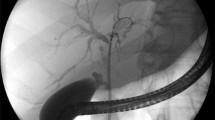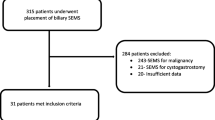Abstract
Background
Endotherapy with plastic stent (PS) placement is the main modality for treating benign biliary strictures (BBSs). Fully covered self-expandable metal stents (FCSEMSs) are being increasingly used for BBS management, with high stricture resolution. However, traditional metal tents are associated with high migration, causing treatment failure.
Methods
We investigated the efficacy and safety of a new FCSEMS for postsurgical BBS treatment and compared these parameters between the FCSEMS and PS treatment through retrospective analysis. The primary outcome measurements included stricture resolution, stricture recurrence, and complications.
Results
In total, 69 patients were included, of whom 32 underwent FCSEMS treatment and 37 underwent PS treatment. The technical success rate and the number of endoscopic retrograde cholangiopancreatography procedures were similar between the groups. The median stenting duration was 5.2 months (range 1.5–15.3) in the FCSEMS group and 10.7 months (range 2.5–22.6) in the PS group (P < 0.01). The stents removal rate was 96.9% in the FCSEMS group and 94.6% in the PS group. The stricture resolution rate based on intention-to-treat analysis was 83.8% in the PS group and 84.4% (27/32) in the FCSEMS group (P = 0.947), whereas the rates from per-protocol analysis were 88.6% (31/35) and 87.1% (27/31), respectively (P = 0.574). Early and late complications were similar between the groups. The median follow-up time was 43 months (range 13–71). The stricture recurrence rate was 11.1% (3/27) in the FCSEMS group and 16.1% (5/31) in the PS group (P = 0.435).
Conclusions
The new FCSEMS and the PS approach showed similar efficacy and safety in postsurgical BBS treatment. However, the FCSEMS required fewer procedural steps and shorter stenting time, making it an effective alternative modality.



Similar content being viewed by others
References
Sharma S, Gurakar A, Jabbour N. Biliary strictures following liver transplantation: past, present and preventive strategies. Liver Transpl. 2008;14:759–769.
Perri V, Familiari P, Tringali A, et al. Plastic biliary stents for benign biliary diseases. Gastrointest Endosc Clin N Am. 2011;21:405–433.
Davids PH, Tanka AK, Rauws EA, et al. Benign biliary strictures. Surgery or endoscopy? Ann Surg. 1993;217:237–243.
Chan CH, Telford JJ. Endoscopic management of benign biliary strictures. Gastrointest Endosc Clin N Am. 2012;22:511–537.
Judah JR, Draganov PV. Endoscopic therapy of benign biliary strictures. World J Gastroenterol. 2007;13:3531–3539.
Costamagna G, Pandolfi M, Mutignani M, et al. Long-term results of endoscopic management of postoperative bile duct strictures with increasing numbers of stents. Gastrointest Endosc. 2001;54:162–168.
Draganov P, Hoffman B, Marsh W, et al. Long-term outcome in patients with benign biliary strictures treated endoscopically with multiple stents. Gastrointest Endosc. 2002;55:680–686.
Cahen DL, van Berkel AM, Oskam D, et al. Long-term results of endoscopic drainage of common bile duct strictures in chronic pancreatitis. Eur J Gastroenterol Hepatol. 2005;17:103–108.
Pasha SF, Harrison ME, Das A, et al. Endoscopic treatment of anastomotic biliary strictures after deceased donor liver transplantation: outcomes after maximal stent therapy. Gastrointest Endosc. 2007;66:44–51.
Traina M, Tarantino I, Barresi L, et al. Efficacy and safety of fully covered self-expandable metallic stent in biliary complications after liver transplantation: a preliminary study. Liver Transpl. 2009;15:1493–1498.
Mahajan A, Ho H, Sauer B, et al. Temporary placement of fully covered self-expandable metal stents in benign biliary strictures: midterm evaluation. Gastrointest Endosc. 2009;70:303–309.
Haapamaki C, Udd M, Halttunen J, et al. Endoscopic treatment of anastomotic biliary complications after liver transplantation using removable, covered, self-expandable metallic stents. Scand J Gastroenterol. 2012;47:116–121.
Poley J, Cahen D, Metselaar H, et al. A prospective group sequential study evaluating a new type of fully covered self-expandable metal stent for the treatment of benign biliary strictures. Gastrointest Endosc. 2012;75:783–789.
Sauer P, Chahoud F, Gotthardt D, et al. Temporary placement of fully covered self-expandable metal stents in biliary complications after liver transplantation. Endoscopy. 2012;44:536–538.
do Park H, Lee SS, Lee TH, et al. Anchoring flap versus flared end, fully covered self-expandable metal stents to prevent migration in patients with benign biliary strictures: a multicenter, prospective, comparative pilot study. Gastrointest Endosc. 2011;73:64–70.
Moon J, Choi H, Koo H, et al. Feasibility of placing a modified fully covered self-expandable metal stent above the papilla to minimize stent induced bile duct injury in patients with refractory benign biliary strictures. Gastrointest Endosc. 2012;75:1080–1085.
Kasher J, Corasanti J, Tarnasky P, et al. A multicenter analysis of safety and outcome of removal of a fully covered self-expandable metal stent. Gastrointest Endosc. 2011;73:1292–1297.
Giacino C, Grandval P, Laugier R. Fully covered self-expanding metal stents for refractory pancreatic duct strictures in chronic pancreatitis. Endoscopy. 2012;44:874–877.
Hu B, Gao DJ, Yu FH, et al. Endoscopic stenting for post-transplant biliary stricture: usefulness of a novel removable covered metal stent. J Hepatobiliary Pancreat Sci. 2011;18:640–645.
Cotton PB, Lehman G, Vennes J, et al. Endoscopic sphincterotomy complications and their management: an attempt at consensus. Gastrointest Endosc. 1991;37:383–393.
Carola Haapamäki, Kylänpää Leena, Udd Marianne, et al. Multiple plastic versus covered metallic stents for biliary stricture in chronic pancreatitis. Endoscopy. 2015;47:605–610.
Tabibian JH, Asham EH, Han S, et al. Endoscopic treatment of postorthotopic liver transplantation anastomotic biliary strictures with maximal stent therapy. Gastrointest Endosc. 2010;71:505–512.
Deviere J, Cremer M, Baize M, et al. Management of common bile duct stricture caused by chronic pancreatitis with metal mesh self-expandable stents. Gut. 1994;35:122–126.
Rossi P, Bezzi M, Salvatori FM, et al. Recurrent benign biliary strictures: management with self-expanding metallic stents. Radiology. 1990;175:661–665.
Van Berkel AM, Cahen DL, van Westerloo DJ, et al. Self-expanding metal stents in benign biliary strictures due to chronic pancreatitis. Endoscopy. 2004;36:381–384.
Zoepf T, Maldonado-Lopez E, Hilgard P, et al. Balloon dilatation versus balloon dilatation plus bile duct endoprostheses for treatment of anastomotic biliary strictures after liver transplantation. Liver Transpl. 2006;12:88–94.
Author information
Authors and Affiliations
Corresponding author
Ethics declarations
Conflicts of interest
Jun Wu, Dong-xun Zhou, Tian-tian Wang, Dao-jian Gao, and Bing Hu have no conflicts of interest or financial ties to disclose.
Rights and permissions
About this article
Cite this article
Wu, J., Zhou, Dx., Wang, Tt. et al. A New Fully Covered Self-Expandable Metal Stent for the Treatment of Postsurgical Benign Biliary Strictures. Dig Dis Sci 62, 2550–2557 (2017). https://doi.org/10.1007/s10620-017-4698-4
Received:
Accepted:
Published:
Issue Date:
DOI: https://doi.org/10.1007/s10620-017-4698-4




